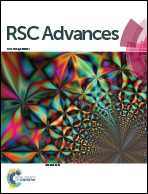Synthesis and optoelectronic investigations of triarylamines based on naphtho[2,3-f]quinoxaline-7,12-dione core as donor–acceptors for n-type materials†
Abstract
In this work, we have synthesized a new series of donor–acceptor system (2–7) involving electron donor triarylamines and electron acceptor naphtho[2,3-f]quinoxaline-7,12-dione by employing palladium catalyzed C–N bond forming amination reaction in good yields and fully characterized. Absorption spectra of all the synthesized molecules showed an intramolecular charge transfer (ICT) transitions in the range of 405–561 nm. Electrochemical properties of the compounds were studied by cyclic voltammetry and differential pulse voltammetry. The HOMO and LUMO energy levels of 2–7 are in the range of −4.88 to −5.57 eV and −3.37 to −3.48 eV respectively. Low-lying LUMO energy levels of 2–7 are comparable to well-known electron transporter materials and make them potential candidates as n-type semiconducting materials.
![Graphical abstract: Synthesis and optoelectronic investigations of triarylamines based on naphtho[2,3-f]quinoxaline-7,12-dione core as donor–acceptors for n-type materials](/en/Image/Get?imageInfo.ImageType=GA&imageInfo.ImageIdentifier.ManuscriptID=C6RA11149A&imageInfo.ImageIdentifier.Year=2016)

 Please wait while we load your content...
Please wait while we load your content...